Quality of the Environment in Japan 1994
(2) Present Situation
a. Certification of Minamata Disease
As of December 31, 1993, the status of the certification of sufferers was as follows:
Kumamoto Kagoshima
Prefecture Prefecture
Number of living certified 851 289
sufferers
Number certified under the 1,725 486
Relief Law or Compensation
Law
Number certified but deceased 44 1
before enactment of the Relief
Law
Number waiting for certification 1,882 157
Certification procedures have moved relatively smoothly in recent years, and since 1986, the number of unprocessed applications has steadily declined. Nevertheless the number of such applications (and reapplications) remains high in part because of such circumstances as refusal of examinations by some applicants, difficulty of making judgments because of the advanced age of the applicants, death of some prior to undergoing examinations, and the bed-ridden condition of some applicants.
The status of certification of sufferers (Niigata Minamata Disease) in the Agano River basin was as follows as of December 31, 1993:
Niigata
Prefecture
Number of living certified 424
sufferers
Number certified under the 685
Relief Law or Compensation
Law
Number certified but deceased 5
before enactment of the Relief
Law
Number waiting for certification 3
It will be necessary for Kumamoto Prefecture and Kagoshima Prefecture to make further efforts to speed up the certification procedure. In addition to maintaining the expanded system for health examinations and screening, it is important to respond to the needs of those who have not taken health examinations because, for example, they currently reside in other prefectures. For such applicants, examination facilities have been established outside the designated areas in Nagoya, Osaka, and Tokyo.
The official certification of sufferers with Minamata Disease has been made on the basis of medical judgments, and the appropriateness of the criteria for such judgments was reconfirmed by a meeting of medical specialists in October 1985. Also, in the report issued in November 1991 by the Central Council for Environmental Pollution Control, entitled Appropriate Measures for Dealing with Minamata Disease, no findings were presented that make it necessary to alter the criteria.
b. Medical Treatment Research Program
This program has been carried out since 1974 with the objectives of subsidizing the medical care costs borne by applicants for certification whose examinations and judgment require considerable time and monitoring and understanding changes in their conditions.
c. Program to Develop Comprehensive Measures
Efforts have been made for the fair relief of sufferers from Minamata Disease under the Compensation Law. Health problems, however, remain for local residents, thus posing serious social issues. The Environment Agency has requested advice from the Central Council for Environmental Pollution Control regarding comprehensive measures to deal with these issues, and the Council has responded with recommendations entitled On Future Measures to Cope with Minamata Disease.
Based on these recommendations, the Environment Agency has implemented a program entitled Comprehensive Measures for Miriamata Disease, which consists of a health care project, including mass health screenings, for persons who may have been exposed to methylmercury compound, and a fully subsidized medical care project for treatment and recuperation of persons who have sensory impairment in the extremities. As of December 31, 1993, 3,572 people had undergone examination and/or treatment under this program.
d. Protests Regarding Administrative Dismissal of Applications for Certification of Minamata Disease
The status of protests and requests for reviews of administrative dismissals of applications for certification of Minamata Disease as of December 31, 1993 was as follows:
Under the Under the
Relief Law Compensation
Law
Requests for reviews of adminis- 629 674
trative dismissal
Dismissal reversed 12 6
Request rejected 2 2
Dismissed 380 225
Withdrawn 35 65
e. Minamata Disease-Related Lawsuits
Lawsuits filed against the national government, prefectures, and other defendants by organizations of applicants and others to prevent the spread of Minamata Disease and to obtain relief for sufferers are pending at nine courts.
Since September 1990, six courts have recommended reconciliation in lawsuits in which damages are demanded in conjunction with Minamata Disease around Minamata Bay. The national government has responded that negotiations or other forms of reconciliation are not appropriate in these lawsuits since they involve questions of the basic nature of governmental administration and has therefore indicated it is difficult to comply with the requests for reconciliation.
To date a number of judgments have been made by courts regarding lawsuits involving requests for damages in which the national government, prefectures, and companies responsible were defendants.
1. On March 30, 1987, the Kumamoto District Court issued a decision regarding a case in which the defendants were the national government, Kumamoto Prefecture, and Chisso. The court found the plaintiff to be suffering from Minamata Disease and recognized the responsibility of Chisso, the national government, and Kuinamoto Prefecture to pay damages.
2. On February 7, 1992, the Tokyo District Court issued a decision regarding a case in which the defendants were the national government, Kumamoto Prefecture, and Chisso. The court found that the plaintiff could not be diagnosed as having Minamata Disease. It, however, recognized the responsibility of Chisso to pay damages, but declared the national government and Kumamoto Prefecture were not liable for payment of damages.
3. On March 31, 1992, the Niigata District Court provided a verdict regarding a case in which the defendants were the national government and Showa Denko. The court declared that the plaintiff's sensory impairment in the extremities was presumably due to Minamata Disease and recognized the responsibility of Showa Denko to pay damages by concluded that the national government was not responsible for damage payments.
4. On March 25, 1993, the Kumamoto District Court issued a decision regarding a case in which the national government, Kumamoto Prefecture, and Chisso were the defendants. The court declared it appropriate to conclude that the health damage incurred by the plaintiff was the result of the influence of methylmercury compound and found Chisso, the national government, and Kumamoto Prefecture liable for payment of damages.
5. On November 26, 1993, the Kyoto District Court issued a verdict concerning a case in which the national government, Kumamoto Prefecture, and Chisso were the defendants. The court recognized that the plaintiff was suffering from Minamata Disease and that Chisso, the national government, and Kumamoto Prefecture were liable for payment of damages.
All of the above verdicts are being appealed.
f. Financial Support for Chisso
Chisso, which was the source of the pollution emissions, has directly compensated sufferers from Minamata Disease. Adhering strictly to the Polluter Pays Principle and giving consideration to the necessity to ensure the continuation of compensation and the economic and social stability of the Minamata region, the government has requested banking institutions having relationships with Chisso to provide their financial and other support in accordance with the agreement, entitled On Measures to Cope with Minamata Disease, reached by the Cabinet in June 1978. In addition, Kumamoto Prefecture has lent funds raised in the issuance of prefectural bonds (prefectural bond assistance method) to Chisso to provide further support.
In the prolonged recession in recent years, however, Chisso has experienced a sudden deterioration in performance, and there is concern that the company may have difficulty in meeting its compensation payments. Therefore, acting according to the agreement reached by a meeting of Cabinet ministers responsible for Minamata Disease in August 1993, Chisso was provided with additional financial assistance amounting to approximately ¥10.6 billion. These funds were raised through a special issue of prefectural bonds. Funds provided under the prefectural bond assistance method expired with the compensation payments made in fiscal 1993, but as a result of deliberations among government authorities responsible for Minamata Disease and other parties, this assistance method was extended to fiscal 1994 and for another three years through fiscal 1996. In addition, at the meeting of Cabinet ministers responsible for Minamata Disease in November 1993, the necessary decisions were made to extend the assistance to fiscal 1994 and subsequent years.
g. The National Institute for Minamata Disease
The National Institute for Minamata Disease, established in October 1978 as the nation's sole comprehensive medical research institution on Minamata Disease, is engaged in clinical research, basic research, and epidemiological surveys and research for clarification of the clinical manifestations of Minamata Disease and for establishment of therapeutic methodologies. In September 1986, this Institute was designated as a collaborative study center by the World Health Organization (WHO). In October 1993, the Institution sponsored a joint conference with the WHO entitled International Symposium on the Pollution of the Environment and Evaluation of the Impact on Health of Methylmercury. The Institution is organized into one section, three departments, and 11 groups and the authorized number of personnel is 27.
9-1-4 Itai-Itai Disease
(1) Historical Background
Itai-Itai Disease was first reported at a medical society meeting in October 1955 as an illness of unknown cause discovered in the basin of the Jintsu River in Toyama Prefecture. In May 1968, the Ministry of Health and Welfare issued an administrative statement indicating that Itai-Itai Disease was initiated by renal dysfunction that was caused by chronic cadmium poisoning and was followed by osteomalacia. Thereafter in the course of the disease, pregnancy, breast feeding, changes of internal secretion, aging, shortage of calcium, and other circumstances led osteomalacia to develop into Itai-Itai Disease. The statement also indicated that the only source of cadmium identified was effluent discharged from the Kamioka Mining Plant of Mitsui Mining and Smelting Co., Ltd. In December 1969, along with the implementation of the Relief Law, the basin of the Jintsu. River became a designated area, and, in September 1974, the region was designated as a Class II area under the Compensation Law, which superceded the Relief Law.
(2) Present State
As of December 31, 1993, the total number of certified living sufferers was 15. (The total number of sufferers certified under the Relief Law or the Compensation Law was 153.) Also, as of December 31, 1993, 10 sufferers in the designated areas were in need of medical observation, and Toyama Prefecture was conducting health examinations and monitoring their condition.
As of December 31, 1993, seven requests for a review of administrative decisions under the Compensation Law had been filed with the Pollution-Related Health Damage Compensation Grievance Board. Of these, four had been revoked and three such cases dismissed.
9-1-5 Chronic Arsenic Poisoning
(1) Historical Background
The outbreak of chronic arsenic poisoning in the Toroku area of Miyazaki Prefecture was reported on the basis of a survey conducted by Miyazaki Prefecture in July 1972, and the area was designated under the Relief Law in February 1973. A similar outbreak in the Sasagatani area of Shimane Prefecture was reported following a survey conducted by Shimane Prefecture, and the area was designated under the Relief Law in July 1974. Both areas were designated as Class II areas in September 1974 under the Compensation Law, which superceded the Relief Law.
(2) Present State
As of December 31, 1993, there were 74 certified living sufferers in Miyazaki Prefecture (Toroku) and 6 such sufferers in Shimane Prefecture (Sasagatani). The total number of sufferers certified under the Relief Law or Compensation Law was 145 in Miyazaki Prefecture and 21 in Shimane Prefecture.
As of December 31, 1993, 67 requests for reviews of administrative decisions made under the Compensation Law had been filed with the Pollution-Related Health Damage Compensation Grievance Board. Of these, 7 had been revoked, 48 had been dismissed, and 12 cases withdrawn.
9-2 Surveys and Research on Environmental Health
9-2-1 Basic Research on Environmental Health Policy
The Environment Agency began to implement a research project in fiscal 1987 to establish a surveillance system at the earliest possible date which would quickly detect abnormalities and enable the formulation of necessary counterpolicies. The system is based on the periodical and continuous monitoring of the relationships between air pollution and its impact on health. An interim report on this project was issued in fiscal 1992.
Also, to evaluate the impact on health of air pollution, such as the concentration of emissions found along major highways, the Environment Agency began research in fiscal 1987 to establish the proper methods for research into such problems. An interim report on this research was prepared in fiscal 1992.
Other projects include research, begun in fiscal 1991, on the relationship between cedar pollen and air pollution and a study of the effect of ultraviolet radiation on health, begun in fiscal 1993.
In addition, the Pollution Health Damage Compensation and Prevention Association is engaged in research on health damage resulting from air pollution and preventative measures.
9-2-2 Research on the Effect of Cadmium and Other Substances on Health
To take advance measures to prevent health damage from cadmium and in view of the previously mentioned views of the Ministry of Health and Welfare expressed in 1968 regarding the impact of cadmium on health, the Environment Agency carries out health examinations of residents of cadmium-polluted areas. Through these examinations, no additional sufferers from Itai-Itai Disease, other than those in Toyama Prefecture, have been identified. Also, since fiscal 1985, the Environment Agency has conducted health surveys among those recognized as having some of the symptoms of Itai-Iitai Disease during tests conducted in the basin of the Jintsu River from fiscal 1979 through fiscal 1984.
Furthermore, since a number of aspects of Itai-Itai Disease are still unexplained, such as the relationship between the cadmium pollution and dysfunction of proximal renal tubules, and the causes of the disease and cadmium's effect on the human body, the Environment Agency has also conducted the following research projects:
(1) Experiments on larger animals (including older monkeys) involving low-level injections of cadmium over an extended period,
(2) Research on the clinical significance of such symptoms as low molecular weight albuminuria found among residents of cadmiumpolluted areas,
(3) Research on improvements during convalescence of certified sufferers from Itai-Itai Disease, advance prevention measures, and related issues, and
(4) Research into pathological reference materials containing data on certified sufferers and others under observation.
An interim report on the findings of these projects was issued in 1989.
In summary, the conclusion was that further research was needed into the effect of cadmium exposure on kidneys, bones and other parts of the body. Based on research to date, further surveys and research are under way to clarify the effect of cadmium on health.
In addition, to promote scientific research on the effects of water and other forms of pollution on the human body, the Environment Agency is also engaged in comprehensive research on Minamata Disease and on the effects of heavy metals and other substances on the human body.
Chapter 10. Settlement of Pollution Disputes and Handling of Pollution Offenses
10-1 Settlement of Environmental Pollution Disputes and Grievances about Pollution
10-1-1 Settlement of Environmental Pollution Disputes
The Law for the Settlement of Environmental Pollution Disputes stipulates that pollution disputes shall be settled by the Environmental Dispute Coordination Commission, an external body of the Prime Minister's Office and by Prefectural Environmental Dispute Settlement Committee established by each prefecture. The system for settlement of disputes is outlined in Figure 10-1-1.
Fig. 10-1-1 Pollution Disputes Processing System
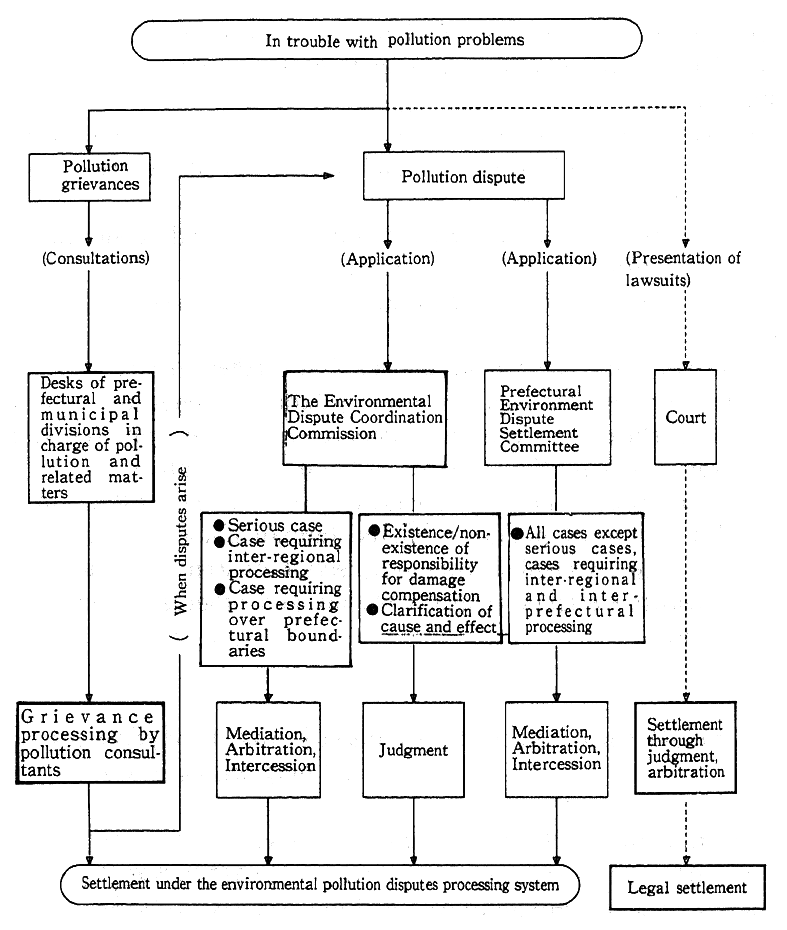
The procedures for the settlement of environment pollution disputes comprise mediation, arbitration, intercession, and judgment. Judgment is divided into two types. The first type is where judgment is provided regarding responsibility, namely the presence or absence of responsibility for payment of compensation for damages related to pollution. The second type is where judgment is provided regarding the presence or absence of a causal relationship between alleged polluting activities and damages from pollution.
The Environmental Dispute Coordination Commission is exclusively responsible for judgment. In serious cases, such as Minamata Disease and Itai-Itai Disease, and cases of aircraft and Shinkansen train noise, the Commission carries out mediation, arbitration, and intercession. Prefectural Environmental Dispute Settlement Committees conduct mediation, arbitration, and intercession for all other cases.
(1) Cases Handled by the Environmental Dispute Coordination Commission
In fiscal 1993, the Environmental Dispute Coordination Commission accepted 6 new cases. Including the 6 pending cases of the previous year, 12 cases were handled in 1993. (Of these, 8 involved arbitration and 4 involved judgment on responsibilities.) The cases were as follows:
(a)Cases for Arbitration
1. Cases in which arbitration was requested forthe compensation of damages from Minamata Disease along the coast of the Sea of Shiranui 2 cases
2. Cases in which arbitration was requested to prevent noise from the Hokuriku Shinkansen Trains 2 cases
3. Case in which arbitration was requested regarding damages from noise and, vibration of the Tokaido Shinkansen Trains 1 case
4. Case in which arbitration was requested regarding damages from water pollution caused by liquid detergents 1 case
5. Cases in which arbitration was requested regarding damages from water pollution cause by industrial waste emissions of Toyoshima Sangyo 2 cases
(b) Cases for Judgment on Responsibilities
Cases in which judgment was to be made on responsibility for noise of the Odakyu Train 4 cases
One case, for arbitration of the compensation of damages from Minamata Disease along the coast of the Sea of Shiranui, was concluded in fiscal 1993 and the remaining 11 cases were carried over to fiscal 1994.
(2) Cases Handled by Prefectural Environmental Dispute Settlement Committees
Prefectural Environmental Dispute Settlement Committees accepted 49 cases regarding environmental pollution disputes in 1993. Together with the 75 cases carried over from the previous year, a total of 124 cases (all of which were cases for arbitration) were handled in 1993. A total of 49 cases were settled in 1993.
An example where arbitration was completed is as follows. On January 28, 1993, an applicant for arbitration living near a gasoline service station (the defendant in this case) in Fukui City filled a request for arbitration on the grounds that the automatic car washing machine made noise and other disturbances and prevented the applicant from sleeping and leading a peaceful life. The applicant therefore requested that the defendant install equipment to lower the noise level.
The Fukui Prefectural Environmental Dispute Settlement Committee was successful in completing the arbitration of the dispute on April 8, 1993. The principal articles of the arbitration agreement were as follows
(1) The station set its business hours on weekdays and Saturdays at 7:40 A.M. to 11:00 P.M. and on Sundays and holidays at 8:00 A.M. to 8:00 P.M.
(2) The station agreed not to operate its car washing machine after 8:00 P.M. on weekdays and Saturdays and 5:00 P.M. on Sundays and holidays.
(3) The station also agreed to reduce the noise of pump attendants and machines after 8:00 P.M.
(4) To soundproof the applicant's house, the applicant equipped the soundproof apparatus at the station's expense.
10-1-2 Disposition of Grievances about Environmental Pollution
(1) System for Settlement of Grievances about Environmental Pollution
Grievances regarding pollution are closely linked to the daily lives of residents of the affected areas. Therefore the appropriate settlement is extremely important for maintaining the living environment and for preventing future environmental pollution disputes.
From this perspective, the Law for the Settlement of Environmental Pollution Disputes stipulates that local governments shall cooperate with related governmental administrative institutions in appropriately settling grievances about environmental pollution. For this purpose, it is also stipulated that prefectures and municipalities may assign personnel to act as environmental pollution grievance consultants.
The Environmental Dispute Coordination Commission provides guidance and information to assist local governments in dealing appropriately with pollution-related grievances.
(2) Present State of Grievances about Environmental Pollution
Grievances about environmental pollution newly filed with local governments across the nation in fiscal 1992 totaled 76,186, down 0.7%, or 527 from the previous fiscal year.
As shown in Figure 10-1-2, such grievances reached a peak of 87, 764 in fiscal 1972, then declined from fiscal 1973 through fiscal 1982. In fiscal 1983, however, grievances began to rise again and in fiscal 1992 were still above 70 thousand as in the previous year.
Of the total number of grievances in fiscal 1992, 44,976, or 59.0%, were related to the seven typical kinds of environmental pollution. Such grievances amounted to somewhat more than 50 thousand during the ten-year period beginning in fiscal 1979, but fell below that level in fiscal 1989. In fiscal 1992, such grievances amounted to about 45 thousand. Grievances about matters other than the seven typical kinds of environment pollution have been on the increase since fiscal 1977. In fiscal 1992, these amounted to 31,210, 1,147, or 3.8%, higher than in the previous year and accounted for somewhat more than 40% of all grievances (Figure 10-1-3).
Fig. 10-1-2 Trends in Number of Grievances
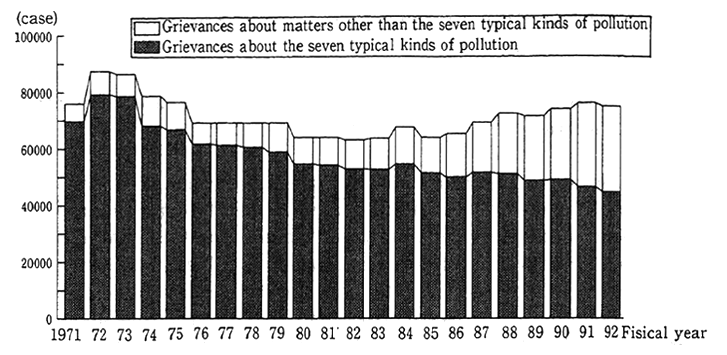
Source: Environmental Dispute Coordination Commission Report of Survey on Number of Grievances about Environmental Pollution in Fiscal 1992
Fig. 10-1-3 Treads in Number and Composition of Grievances
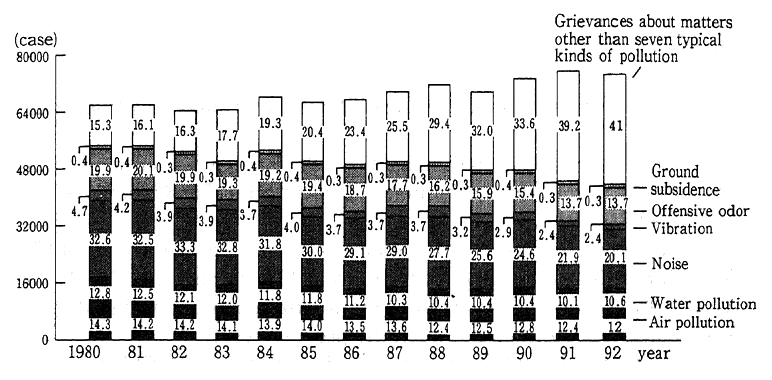
Source: Environmental Dispute Coordination Commission, Report of Survey on Number of Grievances about Environmental Pollution in Fiscal 1992
Note: Values in the figure are composition ratios.
(3) Settlement of Grievances about Environmental Pollution
In fiscal 1991, 72.7% of grievances were settled within one month from the time the complaint was made. About 25.8% of the complainants responded that they were "satisfied" with the settlement and 47.5% were "more or less satisfied." Thus about three-fourths of the complainants felt some degree of satisfaction with the outcome (Figures 10-1-4 and 10-1-5)
Fig. 10-1-4 Terms Required for Settlement of Grievances about Environmental Pollution

Source : Environmental Dispute Coordination Commission, The State of Environmental Pollution Dispute in Local Public Bodies in Fiscal 1991
Fig. 10-1-5 Degree of Satisfaction with Grievance Settlements

Source : Environmental Dispute Coordination Commission, The State of Environmental Pollution Dispute in Local Public Bodies in Fiscal .1991
10-1-3 The State of Settlement of Grievance about Environmental Pollution by the Police
In fiscal 1993, 71,743 grievances about environmental pollution (excluding those related to traffic pollution here and below) were accepted by the police; a 5,415 increased compared with the number of the previous fiscal year.
The number and composition of such grievances is shown in Table 10-1-1. Complaints related to noise accounted for 93.3% and continued to be the largest single category.
The police response to such grievances is shown in Table 10-1-2. Most of these were settled by warnings and guidance from the police.
Table 10-1-1 Pollution Complaints Filed with Police

Source: The National Police Agency.
Table 10-1-2 Police Response to Pollution Grievances (1993)

Source: The National Police Agency.
10-2 Control of Environmental Pollution Offenders
10-2-1 Control Priorities and Arrests
The police place priority on offenses that involve malicious, illegal disposal of industrial wastes and water pollution. Arrests made in connection with environmental pollution offenses amounted to 2,024 in fiscal 1993 and such arrests over the last five years are shown in Table 10-2-1.
Table 10-2-1 Number of Arrests for Pollution Offenses (1989-1993)
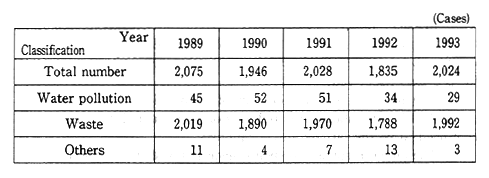
Source The National Police Agency.
Table 10-2-2 Number of Arrests for Pollution Offenses by Law (1993)

Source : The National Police Agency.
The number of arrests in 1993, classified by law and ordinance, is given in Table 10-2-2. Arrests under Waste Disposal and Public Cleaning Law (hereinafter the Waste Disposal Law) accounted for 99,2% of the total.
10-2-2 Control of Water Pollution Offenders
In fiscal 1993, 29 arrests were made in connection with violations of the Water Pollution Control Law. Of this total, 13 arrests were made because wastewater emissions exceeded the levels set by the Water Pollution Control Law and other regulations.
10-2-3 Control of Waste Disposal Offenders
Table 10-2-3 shows a breakdown of the 1,796 arrests made in connection with illegal waste disposal in fiscal 1993.. Illegal dumping remains the largest single category, accounting for 70.0 %.
Table 10-2-3 Arrests by Type of Wastes Disposal Violation (1993)

Source : The National Police Agency.
The total volume of illegally disposed wastes in fiscal 1993 was estimated at 1.45 million tons. A breakdown of such wastes by kind and by place of disposal is shown in Figure 10-2-1. The largest portion consisted of illegally dumped construction wastes, from building sites in urban areas and concrete fragments from demolition of existing buildings, which were dumped in neighboring mountains and other locations without permission.
One example of such activities was the case of a gang that arranged for collection of medical injection needles, construction wastes, and other wastes and disposed of them illegally. To cover up his actions, he had counterfeit manifests prepared that showed the wastes were being disposed of legally. Charges were brought against one company and five individuals and three of the individuals were arrested because of the violation of the Waste Disposal Law.
Fig. 10-2-1 Illegal Disposal of Industrial Wastes

Source: The National Police Agency
10-2-4 Acceptance and Settlement by Public Prosecutor's Office of Cases in Violation of Laws Related to Environmental Pollution
The acceptance and settlement by the public prosecutor's office of cases in violation of laws related to environmental pollution from 1989 to 1993 are shown in Table 10-2-4. The number of persons in fiscal 1993 was 3,237, or a 78 increase compared with that in the previous year.
Table 10-2-5 shows the number of persons on charges of violating laws related to environmental pollution. The largest number, 2,036 or 62. 9% of the total, involved violations of the Waste Disposal Law. The number of violations of the Law Related to the Prevention of Marine Pollution and Maritime Disaster and the Water Pollution Control Law. Compared with the previous year, the largest increase, 164 persons, occurred in violations of the Waste Disposal Law, whereas violations of the Law Related to the Prevention of Marine Pollution and Maritime Disasters fell by 51 persons.
Table 10-2-6 shows the number of persons processed in violations of laws related to environmental pollution in fiscal 1993. The number of persons prosecuted amounted to 1,767, or 56.0%, while 1,389 were not prosecuted. Among those prosecuted, 62 were required to stand trial, 4 more than in the previous year. The remaining 1,705, or 11 fewer than in the previous year and 96.5% of the total prosecuted, were required to abide by directives.
Table 10-2-4 Trends in Number of Persons Processed in Connection with Violations of Laws Related to Environmental Pollution
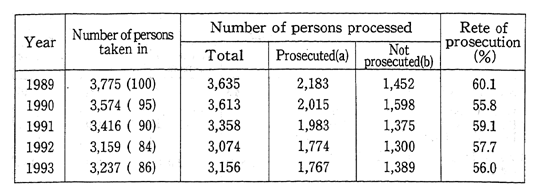
Source : The Ministry of Justice
Notes : 1. Figures in parentheses are an index based in 1989.
2. The rate of prosecution=a/(a+b)×100.
Table 10-2-5 Number of Persons Charged with Violating Laws Related to Environmental Pollution
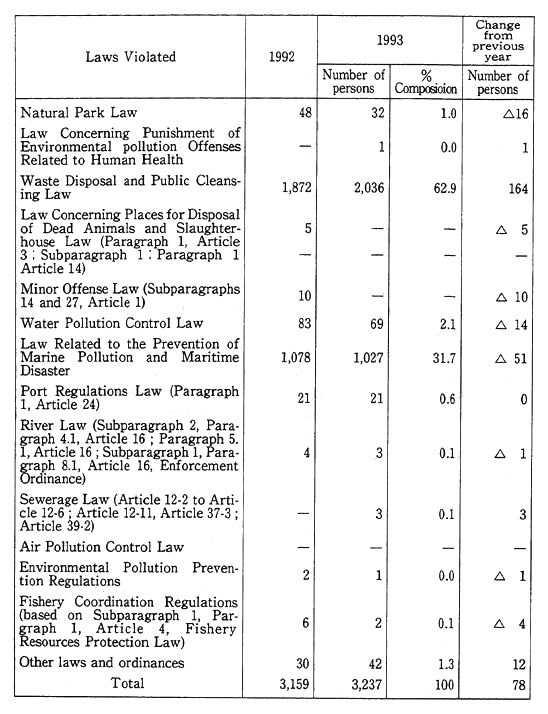
Source : The Ministry of Justice.
Note : Minus signs indicate a decrease.
Table 10-2-6 Number of Persons Processed for Violatins Environinental Pollution Related Laws and Ordinances by Law violated (1992)
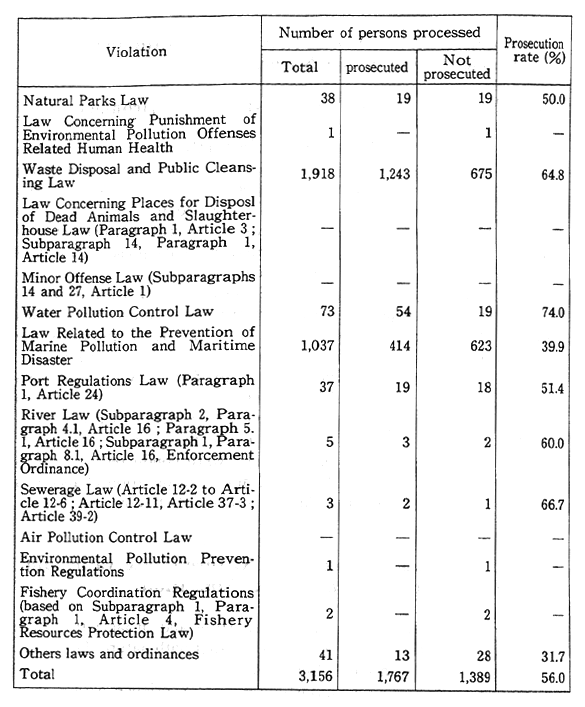
Source : The Ministry of Justice Note : The prosecution rate is the number prosecuted divided by the total of those prosecuted and not prosecuted multiplied by 100 to obtain a percentage figure.
Chapter 11. Conservation of the Natural Environment
11-1 Comprehensive Promotion Measures for the Conservation of the Natural Environment
11-1-1 National Survey on the Natural Environment
Japan's natural environment is constantly undergoing considerable transformation. Changes can be seen in the country's vegetation and natural features, including rivers, lakes and reservoirs, coastline, and surrounding seas, and the wild fauna that live in these habitats. To develop appropriate measures to preserve the natural environment, it is important to have an accurate understanding of its present state and closely monitor the trend of its evolution.
For this purpose, the National Survey on the Natural Environment is carried out approximately every five years in accordance with Article 4 of the Nature Conservation Law. Generally known as the Green Census, the survey aims to gather comprehensive and scientific data on the natural environment. To date, five surveys have been conducted as follows in fiscal 1973, fiscal 1978-79, fiscal 1983-87, fiscal 1988-92. The fifth National Survey, currently in progress, began in fiscal 1993. An outline of the survey is given in Figure 11-1-1.
Additionally, in fiscal 1993, surveys were conducted on Japan's marshlands, etc.; the Wetland Survey, and consideration of methods were started, the Coastal Area Survey, survey of shallow sea areas.
11-1-2 Increasing Awareness of Nature Conservation and Promoting Environmental Education
In recent years, increasing leisure time and urbanization have been accompanied by a desire for closer contact with nature. To protect the environment in locations where people go to interact with nature and provide them with the opportunities to experience nature, it is necessary to encourage responsible behavior and appropriate use of the natural environment.
The following measures were taken by the Environment Agency in fiscal 1993, in response to this trend.
Fig. 11-1-1 Outeline of the Fifth National Survey on the Natural Environment
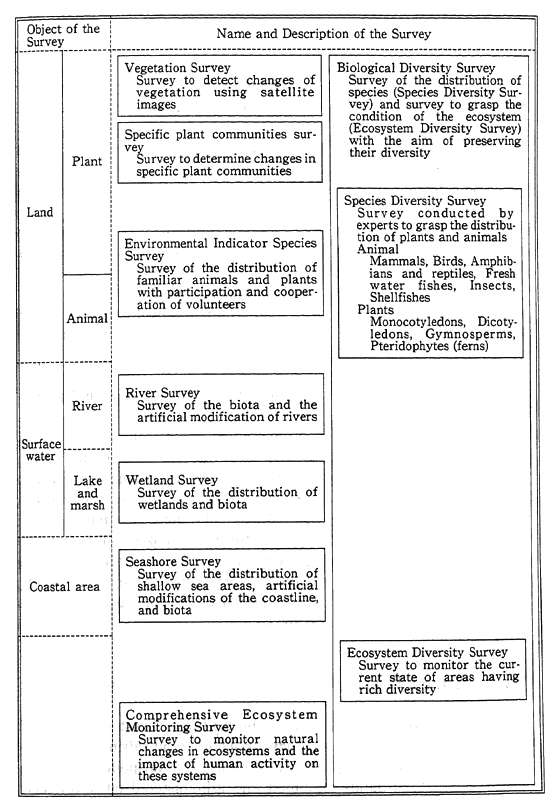
(1) Environment Interaction Events
Making use of Visitor Centers and Nature Trails, the Environment Agency sponsored the following events aimed at deepening the public's understanding of nature and increasing their appreciation of the importance of maintaining an ethical attitude towards conservation of the environment.
(A) April 29, Greenery Day, is a national holiday in Japan, and on this day, "Greenery Day Gatherings for Communication with Nature" were held in public parks throughout the country, such as the Shinjuku-Gyoen National Garden in Tokyo.
(B) During the Campaign for Communication with Nature, between July 21 and August 20, various events were held in natural parks. The principal such event was the 35th Natural Park Festival, which was held in the Akiyoshidai National Park, Yamaguchi Prefecture.
(C) A "National Trail Month" campaign was held in all 47 prefectures in October, aimed at raising public awareness of environmental conservation.
(2) Training Leaders to Promote Communication with Nature
The Environment Agency conducted "Park Volunteer Projects" in Towada Hachimantai National Park in the Hakkoda region and in national parks in eight other regions to enlist the support of the public in environment conservation projects. Also, to train guides who can interpret nature, the Agency held "Nature Training Seminars."
The Agency provides training for natural park custodians on various topics, including the protection of wild flora and fauna, the promotion of park beautification, and the prevention of accidents. Guidance is also provided to natural park users on appropriate practices while in the confines of natural parks.
11-1-3 Citizen Participation in Nature Protection
Modelled on activities run by the National Trust in the United Kingdom, the Environment Agency sponsors fund-raising campaigns and promotes programs to purchase large areas of unspoiled wilderness and then have these lands managed and administered on a volunteer basis. One example of the many programs currently under way in Japan is the "Tenjinzaki Citizens Conservation Campaign", in Wakayama Prefecture.
This type of activity has proved to be particularly rewarding for members of the community, and the Agency intends to further promote similar conservation projects with participation of the general public.
In fiscal 1993, Non-Profit Nature Conservation Organizations -those non-profit organizations whose primary purpose is to purchase and manage unspoiled areas of wilderness-were recognized as specialpurpose corporations for the promotion of the public good and, as such, are eligible for preferential taxation treatment, including exemption from paying taxes on contributions received.
The Environment Agency held a symposium at the 11th National Conference of the National Trust to further explain the aims of the activities being performed by the National Trust.
11-2 Conservation of Natural Parks
11-2-1 Designation of Nature Conservation Areas
Under the provisions of the Nature Conservation Law, the government can designate certain areas to receive special environmental protection. These areas are classified into one of two broad categories: (1) wilderness areas, those areas which remain unaffected by civilization; and (2) nature conservation areas, those areas where it is considered important from an environmental and social perspective to maintain the environment in its natural state.
At the end of fiscal 1993, 5 areas had been designated under the first category and 10 under the second.
Table 11-2-1 Areas Designated for Nature Conservation
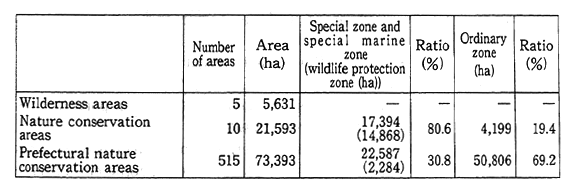
Remarks : Surveyed by the Environment Agency.
Prefectural governments can similarly designate land within their jurisdictions as nature conservation areas. At the end of fiscal 1993, 515 areas of land had been so designated by prefectural governments. (Refer to Table 11-2-1)
11-2-2 Protection of Nature in Nature Conservation Areas
In light of the importance of preserving the natural environment in wilderness areas and nature conservation areas, various studies are being conducted to ensure that protection measures are appropriate and adequate. In fiscal 1994, surveys on the state of the natural environment were carried out in all wilderness areas and nature conservation areas in Japan.
In fiscal 1993, studies were made in the Head of River Tokachi Wilderness Area, the Head of River Ooi Wilderness Area, and the Yakushima Wilderness Area. In fiscal 1992, a survey was also performed on the state of the natural environment in the Shirakami Sanchi Nature Conservation Area.
11-2-3 Designation of Natural Parks and Review of Park Plans
(1) Designation of National and Quasi-National Parks
The legal basis of the natural parks is the Natural Parks Law, enacted in 1957. This law aims to conserve scenic areas and their ecosystems, to promote their utilization, and to contribute to the health, recreation, and culture of the people. The Natural Parks Law prescribes three types of natural park
(A) National Parks: Places with excellent scenic beauty and ecosystems, worthy of the name of national scenic and outstanding ecosystem site in Japan.
(B) Quasi-National Parks: Places with great natural scenic beauty next to the National Parks.
(C) Prefectural Natural Parks: Places with local importance, as designated by the prefectural governments.
Many areas of wilderness have been designated as national parks and have played an important role as places where people can observe and interact with nature and enjoy outdoor activities.
Fig. 11-2-1 Location of National and Quasi-National Parks
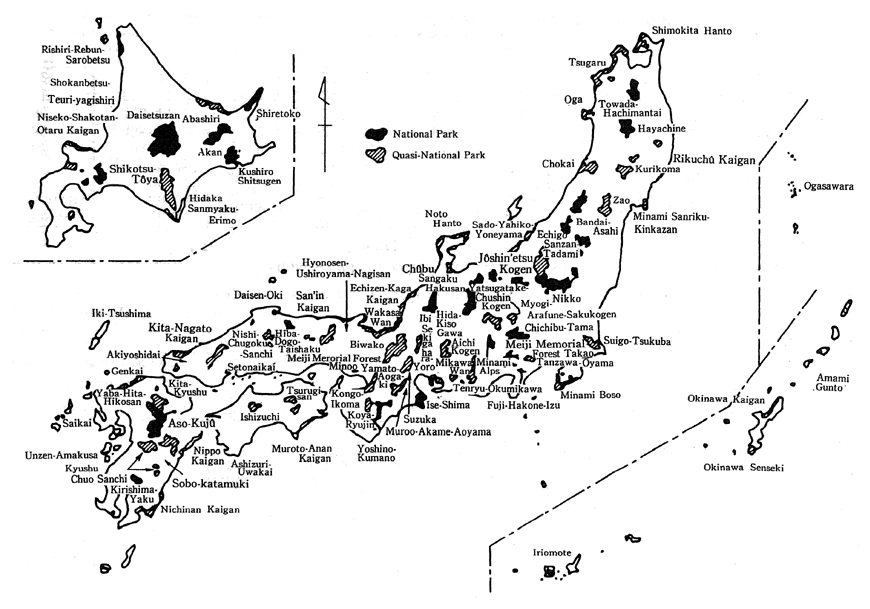
Table 11-2-2 Area of Natural Parks

Remarks 1. Surveyed by the Environment Agency.
2. According to data released by the National Land Institute in October 1992, the national land area was 37,775,028 hectares.
Table 11-2-3 Applications for Permission of Specified Activities in National Parks (Permission by the Director-General of the Environment Agency)

Remarks 1. Surveyed by the Environment Agency.
2. "Other activities" includes changing of land configurations, etc.
3. Figures in parentheses are applications for such activities in special protection zones.
4. Figures include deliberation by organizations of the national government.
In Japan, in fiscal 1994, there were 28 national parks covering an area 2,050,000 hectares ; 55 quasi-national parks covering an area of 1, 330,000 hectares and 301 prefectural natural parks, covering an area of 1,940,000 hectares. Thus, the total area covered by national and prefectural parks was 5,330,000 hectares, which accounts for 14% of the total land area of Japan. (Refer to Figure 11-2-1 and Table 11-2-2)
(2) Designation of Marine Park Areas
The Director-General of the Environment Agency designates marine park areas within national and quasi-national parks, implements necessary regulatory measures to protect the park habitat, and provides guidance on purposes for which the park can be used.
At the end of fiscal 1993, 28 areas in national parks and 58 areas within quasi-national parks covering a total area of 2,439 hectares had been designated as marine parks.
(3) Revision of Park Plans
Park plans are formulated to ensure the habitat within natural parks is adequately protected and that the parks are only used for activities which are not damaging to the natural environment. Since 1973, protection measures under these schemes have been revised to strengthen their effectiveness in light of the changing social environment in areas surrounding natural parks. Revisions are subsequently conducted at approximately five-year intervals to monitor the effectiveness of the protection measures.
In fiscal 1993, revisions were completed at Saikai national park and other parks.
Revisions of park plans for quasi-national parks are carried out by prefectural and national governments along similar lines to those for national parks. In fiscal 1993, inspections were carried out in the Echizen-Kaga Kaigan Quasi-National Park and the Tsurugisan QuasiNational Park.
The Agency also provides guidance to formulate park plans to those prefectures that have not prepared such plans.
(4) Designation of Vehicle Regulated Areas
The revision of the Natural Parks Law in 1990 gave the DirectorGeneral of the Environment Agency authority to designate areas within national parks and quasi-national parks as areas to which entry is restricted for horse-drawn vehicles, automobiles, powerboats, and aircraft take offs and landings.
This measure is designed to prevent increasing damage to wild fauna and flora which has occurred as a result of the escalating number of snow-mobiles, off-road vehicles, and power boats, which are entering national and quasi-national parks.
At the end of fiscal 1993, 26 areas comprising 19 areas in national parks and 7 areas in quasi-national parks had been designated as vehicle regulated areas, covering a total area of 136,680 hectares.
11-2-4 Protection of Nature in Natural Parks
(1) Protection of Scenic Beauty in Natural Parks
(a) Controls on Activities in Natural Parks
In order to protect the scenic beauty in the natural parks, special zones, special protection zones, and marine park zones are designated (refer to Table 11-2-2). Permission is required from the Director-General of the Environment Agency or the relevant prefectural governor to perform various kinds of activities in these zones. When giving permission, efforts are made for the reasonable protection of scenic beauty, such as with the application of "The Guideline to Assess Various Development Activities in National Park Areas (excluding ordinary areas)."
The number of applications for permission made to the DirectorGeneral of the Environment Agency to perform activities in special zones and special protection zones in national parks is listed in Table 11-2-3.
Even in ordinary zones, reports must be made to the relevant prefectural governor when certain activities are to be performed. In the case of golf course development, a policy guideline is formulated for the reasonable protection of the scenery.
(b) Studies and Surveys on Methods for Management of the Scenic Beauty of Natural Parks
It is crucial that management protection systems thoroughly preserve those zones which contain natural features that represent the essence of the beauty of a natural park. To facilitate the development of management systems that effectively achieve this, studies and surveys are conducted to more clearly understand the factors which cause changes to the ecosystems in these areas. In fiscal 1993, studies were conducted to assist in the development of measures for the conservation of the Tottori sand dunes in the San'in-Kaigan National Park.
(2) Environment Conservation Measures in Natural Parks
The following environment protection measures are being conducted in natural parks.
(a) Beautification and Cleaning Projects
Rubbish left behind by people visiting natural parks not only spoils the natural scenery of the park but also causes foul odors and other problems. The Environment Agency is making determined efforts to preserve the environment in areas within national parks popular among visitors, including the promotion of local groups for park beautification, and providing financial assistance for the activities of these groups.
The first Sunday of every August has been designated as Natural Park Cleaning Day, and park clean-ups are organized across Japan.
(b) Projects for the Conservation of Special Plants
In order to preserve some species of flora found in national and quasi-national parks, protection of their ecosystems is also essential. To this end, the Environment Agency provided financial assistance to local governments for vegetation restoration projects. This type of project was conducted in the Oze Marsh in the Nikko National Park and various other locations.
(c) Projects for the Extermination of A cant ha ster planci, etc.
In order to protect the scenic beauty of the marine park zones in the national and quasi national parks where acanthaster planci and drupella cornus are spreading, the Environment Agency is providing financial assistance to local governments for projects to exterminate them.
(d) Measures to Rationalize the Utilization of Automobiles
In accordance with the Outline on the Rationalization of the Utilization of Automobiles in National Parks, produced by the Environment Agency in March 1974, measures are being taken to reduce the damaging effects caused by the proliferation of vehicles in natural parks, which include the destruction of pristine environment areas and he obstruction of the comfortable and safe use of parks. Measures to reduce the impact of vehicles include traffic control based on the Road Traffic Law and the operation of buses to reduce the volume of private vehicles.
(e) Measures for the Conservation of Specified Natural Environment Areas
In order to ensure the adequate protection of valuable ecosystems in national parks, the Environment Agency is continuing to perform a number of projects and surveys. Examples include studies on measures to conserve the spruce forests in the Odaigahara area of the YoshinoKumano National Park and the environment in the Sarobetsu wilderness area of the Rishiri-Rebun-Sarobetsu National Park.
With the cooperation of the district forest office, environment management projects were carried out in the Shiretoko National Park and the Yakushima (Yaku Island) area of the Kirishima-Yaku National Park.
(f) Measures for the Conservation of Lake and Reservoir Environments
In order to conserve the water quality of lakes, reservoirs, and rivers in natural parks, the Environment Agency has made efforts to promote the construction of sewerage facilities and other projects, in particular, specified public sewerage projects for environment conservation purposes.
(3) Strengthening of Management Systems
To date, as regards the administration of national parks, national park offices have been established in all national parks and have been supported by local governments and private citizen organizations. In order to cope with the quickening pace of change in the environment surrounding national parks in recent years, efforts have been made to reinforce national park management systems.
(a) National Park Offices
National Park Offices perform a wide range of duties. These include protecting and managing the scenic beauty and natural features of national parks, providing guidance to park custodians, and educating park visitors about the park environment. In addition to offices in 11 national parks, ranger stations have been established in regions throughout Japan where national parks are located. At the end of fiscal 1994, there were 140 people working at these offices and stations (the socalled "national park rangers").
Further, management plans are formulated in order to carry out management in an appropriate manner in conformity with the actual conditions of each national park. In fiscal 1993, management plans were formulated for 11 areas in 5 national parks (for example, in ShikotsuToya National Park).
(b) Activities of Private Organizations
(1) The Natural Park Beautification and Management Foundation performs a number of projects, including the promotion of park clean-up campaigns, the maintenance and management of park facilities, and the creation of nature conservation education campaigns. The Foundation conducted projects in 18 areas, including the Kiamikochi area of the Chubu-Sangaku National Park and Hyonosen area of the HyonosenUshiroyama-Nagisan Quasi-National Park.
(2) In order to improve the natural environment surrounding the Seto Naikai National Park, the Honshu-Shikoku Linkage Bridge Fund for Natural Conservation conducted a number of projects, including clean -up projects, and provided assistance for nature conservation promotion campaigns.
(3) The Volunteer Fund for Nature Conservation supported 16 volunteer organizations that perform activities such as natural park clean-up projects, wild flora and fauna preservation projects, and nature education campaigns.
(4) Promotion of Private Land Purchases for Nature Protection
The Environment Agency is assisting prefectural governments in purchasing private land for the purpose of maintaining the scenic beauty in national and quasi-national parks and protecting the habitats of birds and other wildlife in national wildlife protection areas. At the same time, it is also talking with landholders in these areas in order to coordinate their rights.
The actual records in the last 5 years are shown in Table 11-2-4. Up to now, 61 plots covering a total area of 6413 hectares (with a total project outlay of ¥12,150 million) have been purchased.
Table 11-2-4 Purchases of Privately Owned Land with Subsidies for Redemptions on Local Grant Bonds
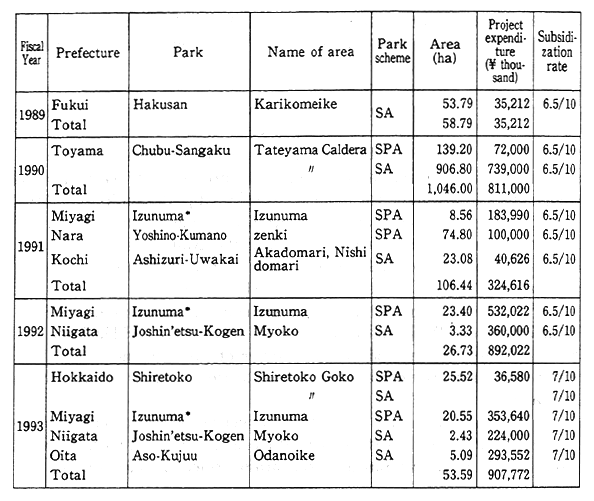
Remarks: 1. Surveyed by the Environment Agency.
2. SA stands for special zone and SPA for special protection zone.
3. Parks marked with an asterisk are wildlife protection areas. All other areas are national parks.
11-3 Conservation of Forests
To conserve the nation's forests, the Japanese Government has promoted suitable forest management based on the Forest Planning System. At the same time, to maintain and increase forest resources and assure that forests perform their many functions, the Forest Land Development Licensing System has been administrated, the Protected Forests System has been implemented, and activities have been promoted to eliminate harmful insects and other problems that damage forests.
11-3-1 Forestry Planning
The Forestry Planning System was administered to provide a comprehensive and sophisticated approach to assure that forests perform their many functions, which include providing wood fiber resources for lumber, prevention of disasters in mountain regions, contributing to water resources, and conservation and building of the environment.
Specific activities included the approval of Special Forest Management Plans that are intended to allow forests to perform sophisticated functions for the public benefit by promoting multi-storied forest and forest management based on a prolonged cutting period. Other activities included working toward the proper implementation of forest improvement plans of local governments that are intended to provide for selective cutting and thinning of trees and other measures to promote forest development and establishment of regional forest plans to implement required measures in specially protected forests as quickly as possible
11-3-2 The Forest Land Development Licensing System
The Japanese Government provided assistance and guidance to prefectural governments on establishing forest land develop licensing systems which effectively achieve the goal of ensuring the proper utilization of forest land. It also assisted in the related areas of inspecting and monitoring forest lands.
11-3-3 Protected Forests
At the end of fiscal 1992, 8.9 million hectares of land had been designated under the Protected Forests System. The objective of this system is to assure that forests perform their roles as public goods, which include conserving natural land resources, contributing to water resources, helping to conserve and improve the natural environment, and providing places for rest and recreation. Based on the Protected Forest Development Program, areas for protection were designated and special designations were provided for forests that had deteriorated and were in need of rehabilitation to restore their environmental functions.
11-3-4 Management of Forest Conservation
The following measures are being taken to ensure forests can perform their many roles in contributing to the environment.
(A) Forest Pest Control Measures
Measures were taken to eradicate forest blight in accordance with the Woodland Disease Insect Extermination Law and provide subsidies for such activities where required. In particular, measures were adopted to prevent the spread of pine weevils in accordance with the Pine Weevil Countermeasures Law. In the cases of pine trees in protected forests, measures that were taken to eliminate weevils, while giving due consideration to the environment, included felling trees badly infected with pine weevils and spraying infected trees with pesticides; spraying insecticides from the air; special measures to fell infected trees and dispose of them by grinding and other means ; supplementary measures to fell and apply trees physically damaged and therefore likely to have been infected by sawyer beetles and pine wood nematodes introduction of great spotted woodpeckers, which are natural enemies of pine weevils In addition to these comprehensive measures, steps were also taken to introduce greater diversity in tree types by planting broad leaved trees in the vicinity of pine forests.
(B) Measures to Prevent Forest Fires
To provide for proper management of forest areas, measures have been taken where there is concern about possible damage to protected areas or other forest lands from fire or other disasters. These measures include forest patrols, distribution of fire fighting equipment to nearby storage areas, cutting of firebreaks and taking other steps to control the spread of fires, and improvement of forest roads to allow easier entry for fire fighting purposes.
(C) Encouraging Cooperation of the Public
To promote the participation and cooperation of the general public in maintaining and improving forest lands, measures adopted included the active promotion of the Proceeds-Sharing Forest System (which allows individuals, groups, and others to become part-owners of tree tracts and share in the profits from their harvesting after 20 to 30 years of growth) ; the promotion of planting and forest improvement activities through the Fund for Forests with Green and Water, which is a national fund obtaining voluntary gifts from individuals and corporations; the conducting of comprehensive research on the improvement, use, and other aspects of forests to respond to the public's expectations concerning forest resources ; and other activities to heighten public understanding and awareness of the nation's forests.
(D) Care of National Forests
Measures were taken to classify national forests into four types by function (land conservation forests, nature maintenance forests, recreational use forests, and timber production forests) and to supervise and manage these lands under the National Forest and Fields Management Regulations. The primary goal in management of public forest lands is maintenance and conservation of the natural environment in these areas.
(E) Protection of Aborigine Forests
Certain areas have been designated as aborigine forests and are managed with the objective of protecting their natural environments, including primeval flora and fauna and genetic resources. Through the end of fiscal 1993, 21 such regions, with a total area of 233,000 hectares, had been designated as protected forest ecosystems, including regions in the vicinity of Mt. Saburu. Of special note was the designation of two of these protected ecosystem regions, the Shirakami Mountains and Yakushima (Yaku Island), as world natural heritage areas under the Convention for the Protection of the World Cultural and Natural Heritage.
(F) Protection of Rare Species
In addition to the foregoing activities, a survey was carried out to form the basis for measures to maintain and improve the natural habitats and environment for rare species of flora and fauna, including the Blakiston's Fish Owl, Iriomote Mountain Cat, and Rebun Lady's Slipper. Based on this survey, steps were taken toward protection of these species through environmental habitat improvement.
11-4 Protection of Wildlife
11-4-1 Protection of Endangered Species
(1) Establishment of the Law for the Conservation of Endangered Species of Wild Flora and Fauna
A study by the Environment Agency to select endangered species in need of emergency protection that was concluded in fiscal 1989 found that there were many species of flora and fauna in Japan that were in danger of extinction. The extinction of plant and animal species has become an important concern among conservationists around the world.
To provide a legal framework to promote the protection of endangered species both in and outside of Japan, the Law for the Conservation of Endangered Species of Wild Fauna and Flora (LCES) was enacted and came into effect on April 1, 1993.
Under the LCES, endangered species which are found within Japan are designated as National Endangered Species and the capture, trade, export, or import of these species is prohibited or regulated. Also, the habitats of these species are designated as Natural Habitat Conservation Areas, and activity within these areas is regulated. The Environment Agency is promoting a variety of other programs to protect endangered species, including breeding programs and the restoration and maintenance of their natural habitats.
Endangered species listed as endangered species under bilateral conventions (or agreements) for conservation of migratory birds and the Washington convention are designated as International Endangered Species, and the transfer, import, and export of these species is regulated.
At the time of the enactment of the LCES, the Law for the Regulation of Trade in Protected Birdlife and the Law for the Regulation of Trade in Endangered Species were repealed.
In January 1994, 6 species were added to the list of 38 species of birds that were designated as endangered in February 1993. These were the Tsushima Cat, Iriomote Cat, Miyako Bitterling, Bekko Dragonfly, Rebun Lady's Slipper, and Callianthemum hondoense (vascular plant).
In addition, plans for protecting and propagating four rare domestic species were prepared in November 1993. These were the ShortTailed Albatross, Japanese Crested Ibis, Japanese Crane, and Blakiston' s Fish Owl.
(2) Protection of Endangered Species
The following projects are being conducted to protect endangered species of Japanese flora and fauna.
(a) Monitoring surveys on habitats of approximately 110 endangered species with the cooperation of local specialists.
(b) For the Japanese Marsh Warbler, White's Ground Thrush, Auston White-Backed Woodpecker, which are designated as "National Endangered Species," surveys have been conducted to determine any changes in their habitats.
(c) A new protection center was finished at the Sado Japanese Crested Ibis Protection Center, which is part of a project to protect this species, and the ibises were moved to the new area. Activities continued to nurture the remaining ibises and arrangements were made for cell preservation.
(d) For the Iriomote Cat, activities included providing food during the winter season and conducting surveys to determine any changes in the habitat and the effectiveness of feeding activities. In addition, work was begun on the Iriomote Wild Flora and Fauna Protection Center, which will serve as the base for surveys and research on the Iriomote Cat and other rare species on Iriomote Island, conduct projects to propagate these species, and carry out various activities to acquaint the public with flora and fauna on the island.
(e) For the Tsushima Cat, activities included providing food during the winter season and conducting surveys of the habitat. Consideration was also given to developing a breeding program for those cats in captivity.
(f) For the Short-Tailed Albatross, construction work was carried out to maintain and improve the birds' breeding areas. In addition, a project was undertaken to lure flocks of the birds to new breeding grounds.
(g) For the Japanese Crane, activities included providing food during the winter season and conducting surveys of the habitat. A survey conducted in January 1994 confirmed the existence of 628 Japanese Cranes.
(h) For Blakiston's Fish Owl, nests and food were provided, and a cage for these owls was installed in the Kiushiro Marshlands Wild Flora and Fauna Center to provide a base to undertake breeding and introduce young owls to new habitats.
(i) For the River Pearl Oyster (kawashinjugai) and Suigenzeni Bitterling, a project was implemented to protect and encourage breeding.
11-4-2 Strengthening Protection and Supervision for Wild Birds and Mammals
(1) Promoting Projects to Protect Birds and Mammals Through Establishment of Protection Areas and Other Measures
Three additional areas were designated as national wildlife protection areas and as specially protected areas, AkkeshiBekanbeushi-Kiritappu, Fuurenko, and Katano Kamoike. In addition, based on the Seventh Plan for Protection of Birds and Mammals, activities to control harmful birds and mammals and provide care for injured birds and mammals were carried out. (Table 11-4-1)
Table 11-4-1 Wildlife Protection Areas
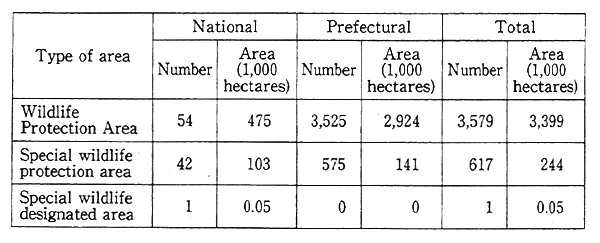
(2) Promotion of Measures for Protection of Migratory Birds
In the Izunuma Lake area of Miyagi Prefecture, which is a designated wildlife protection area and also registered under the Ramsar Convention, a project was implemented to propagate water oats to protect the habitats of the whistling swan (Cygnus columbianus) and other birds that live in and around bodies of water.
The fifth meeting of the Conference of Contracting Parties to the Ramsar Convention was held in Kushiro, Hokkaido, from June 9 through June 16, 1993. At the meeting, which was attended by about 1, 200 participants from 95 countries, a broad-ranging discussion was held, especially about the preservation of marshlands, which are an important habitat of water fowl. This discussion led to a substantially improved awareness of the importance of marshland preservation. Also, during the meetings held on June 10, five additional areas were designated under the Ramsar Convention-Kiritappu Marsh, Akkeshi-Bekanbeushi Marsh, Yatsu Wetlands, Katano Kamoike (duck pond), and Lake Biwa - bringing the total number of such areas in Japan to nine.
To determine the migratory routes and other characteristics of birds, bird-banding surveys were conducted primarily at 60 bird banding stations (10 Class I stations and 50 Class II stations). To develop basic data on the waterfowl, an annual census of Anatidae and a survey of shore birds were carried out.
(3) Measures for Protection of Wildlife and Prevention of Damage
To establish a policy to promote harmony between wildlife protection and human life, the Agency began a project to prepare a Wildlife Management Manual for Specified Regions in fiscal 1992. The subject in fiscal 1993 was the deer. In addition, surveys were conducted with the aim of preventing damage to agriculture and forestry from monkeys and bears indigenous to regions in Japan covering methods of managing these animals and developing technology to avert damage they may cause. A survey was also conducted on ways of preventing damage by crows, doves, and deer.
Based on an agreement among the Environment Agency, the Agency for Cultural Affairs, and the Forestry Agency, measures are being implemented to prevent damage to forestry from the Japanese Serow. Population control measures were adopted in Gifu, Nagano, Aichi, and Yamagata prefectures, where damage was especially serious.
11-4-3 Hunting Controls
(1) Current Hunting Conditions
At present, ducks, pheasants, and 29 other birds and wild boars, deer, and 18 other animals are designated as game species. The number of hunting licenses issued and number of wildlife hunted are shown in Table 11-4-2.
Table 114-2 Number of Hunting Licenses Issued and Wildlife Hunted
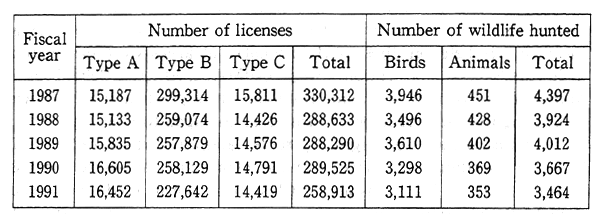
(2) Assurance of Safe Hunting
To assure that hunting is conducted properly and safely, guidance is provided to prefectural governments and hunting associations, including instruction in the correct use of guns prior to hunting and in preventing accidents and violations of hunting laws.
(3) Designation of Hunting Areas
Under the Hunting Area System, certain parts of hunting grounds are specified and, while efforts are made to release game and conduct active breeding programs in those areas, the number of days when hunting is allowed and the number of hunters is restricted in order to assure that these activities are carried out in an orderly manner. Areas specified under this system are shown in Table 11-4-3.
Table 11-4-3 Designated Hunting Areas
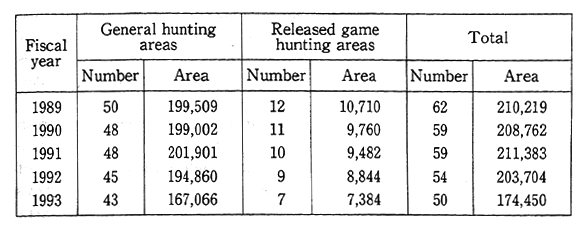
11-4-4 Creating Better Awareness and Understanding of Wildlife Protection
To promote the understanding of wildlife protection among the general public, the Agency sponsored the Japan Wild Birds Protection Conference as part of the program for the 47th Bird Week. In addition, the Meeting for Presentations on Wildlife Protection Activities, primarily by model schools chosen for their bird conservation activities, and other programs were sponsored.
11-4-5 Promotion of Protection and Management of Fishery Resources
To promote the protection and management of fishery resources, restrictions are placed on fish catches based on the Fisheries Law and the Fisheries Resources Protection Law. In addition to these restrictions, which are intended to protect valuable marine resources, the following policies were also implemented.
(a) For those rare fresh water fish which inhabit Japanese waters but are few in number, activities have included exchanging and gathering information on their habitats and on technologies for feeding and for breeding. To protect and expand populations of such fish effectively, an Annual Meeting on Propagation of Rare Fresh Water Fisheries in Japan is held with participants from national fisheries research institutes and prefectural fisheries experiment stations. In addition, surveys were commissioned from prefectures regarding development of breeding technologies and promotion of their acclimatization to the natural environment, principally for newly designated rare fresh water fish.
(b) To promote the protection and propagation of marine flora and fauna for which natural resources have substantially declined, new protected areas have been designated under the Marine Resources Protection Law and necessary supervision and research was undertaken.
(c) To prevent newly born ayu fish that have been released into fresh water environments from straying into intakes for water or waste water outlets for agricultural purposes and promote the efficient use of fisheries resources, a new project has been instituted involving surveys of the extent to which these fish stray into such areas and development of technologies to prevent this behavior.
(d) To protect sea turtles, necessary restrictions on their capture have been imposed under prefectural regulations for fisheries adjustment and through the directives of the Marine Fisheries Adjustment Commission, based on the Fisheries Law and the Fisheries Resource Protection Law. In addition, two additional types of sea turtles, three types of whales, and dugongs have been designated by the ministerial ordinances of the Ministry of Agriculture, Forestry, and Fisheries and necessary measures taken for their protection. Assistance was also continued to support prefectural projects in waters inhabited by sea turtles and other marine life to remove wastes, such as piled vinyl bags, and prevent poaching of turtle eggs and hutchlings. As a measure to protect sea turtles, surveys were also newly commissioned to the prefectures involving release of identification markers and investigation of eating habits and hatching of eggs.
11-5 Provision of Facilities to Enable Interaction with Nature
11-5-1 Provision of Natural Park Facilities
The number of persons who visited natural parks in 1992 increased 0.5% from the previous fiscal year, to 1,019 million people. To meet increasing demand among the community for greater interaction with nature and provide an outlet for relaxation, the Environment Agency is working to preserve a diverse range of natural environments and provide basic facilities that blend with the qualities of these environments. An outline of facilities provided by the Agency is contained in Figure 11-5-1.
Fig. 11-5-1 Outline of the National Park System
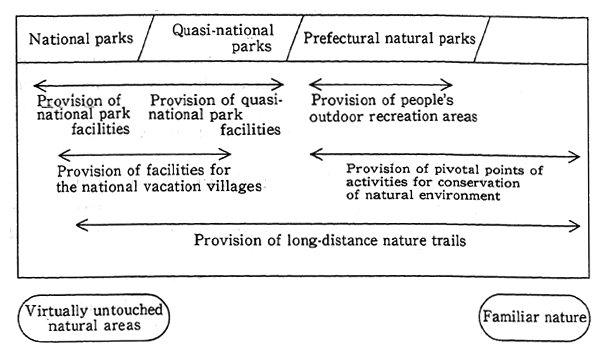
(1) Facilities in National and Quasi-National Parks
Basic facilities provided in national and quasi-national parks include picnic sites, nature trails, camping sites, and lavatories. In fiscal 1991, a project for the urgent restoration of lavatories commenced and is still in progress. Along with this, in fiscal 1993 the Environment Agency commenced the construction of family camping grounds with high quality features where people can stay for extended periods of time. These facilities are known as ecology-camps.
An outline of the facilities available in national and quasinational parks is given in Table 11-5-1.
Table 11-5-1 Projects Undetaken in National and Quasi-National Parks in Fiscal 1993
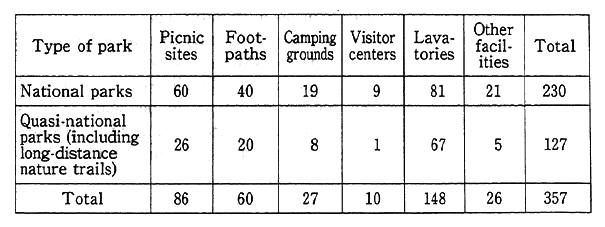
Remarks : Survey by the Environment Agency.
(2) National Vacation Villages
Focusing on reasonably priced, comfortable grounds in scenic areas of national and quasi-national parks, the Environment Agency provides a range of facilities that allow people to stay in natural parks and experience nature first hand. There are National Vacation Villages in 32 locations available for public use.
Free public facilities available at National Vacation Villages including picnic sites, walking trails, and camping grounds are maintained by the national or local governments. On the other hand, the upkeep and management of pay-facilities such as hotels, lodges, and ski lifts is carried out by National Vacation Village Associations.
Trends in the numbers of people using National Vacation Villages are given in Table 11-5-2.
Table 11-5-2 Number of Users of National Vacation Villages
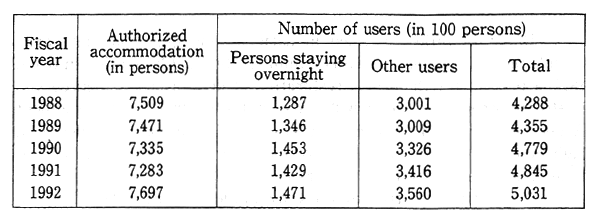
Source : Survey by the Environment Agency.
(3) People's Outdoor Recreation Areas with Natural Parks
People's outdoor recreation areas with natural parks are intended to give people living in urban areas the opportunity to experience nature at first hand and raise their awareness of the importance of maintaining harmony between human beings and nature. Facilities in recreational areas including places where nature displays can be held, such as Natural Park Centers, picnic sites, camping sites, and nature trails, are being maintained and updated under five year programs. In fiscal 1993, projects were under way in five regions.
11-5-2 Provision of Facilities to Promote Outdoor Activities and Recreation and Interaction with Nature
(1) People's Lodges
The purpose of these facilities is to provide people with reasonably priced, tidy accommodations and a place to rest in a scenic natural environment. At the end of fiscal 1992 there were 286 people's lodges in operation, which were used by 8.92 million people during the fiscal year. (Table 11-5-3)
Table 11-5-3 Number of Persons Using People's Lodges
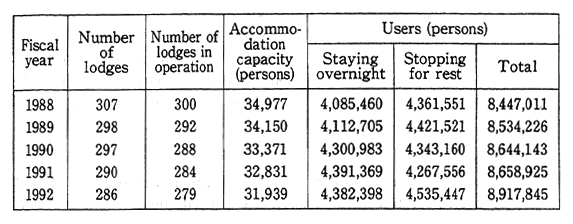
Note The difference between the number of lodges and the number of lodges in operation is the number of lodges temporarily closed.
Table 11-5-4 Usage of People's Recreation Centers

Source : Surveyed by the Environment Agency.
(2) People's Recreation Centers
The primary purpose of these centers is to provide places where people living in urban areas can take day trips and enjoy recreational activities and relax in a natural environment. At the end of fiscal 1992, there were 67 people's recreation centers that were visited by 3.19 million people during the fiscal year. (Table 11-5-4)
Table 11-5-5 Pivotal Points of Activities for Conservation of the Natural Environment
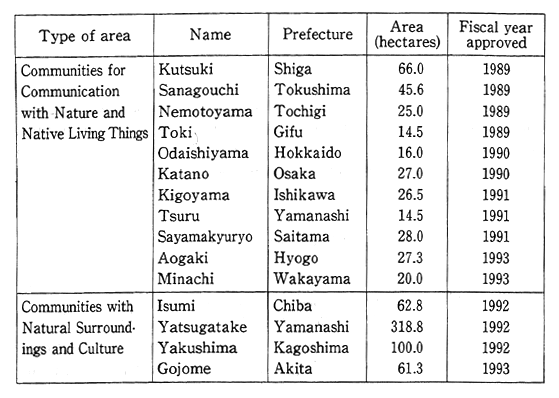
(3) Pivotal Points of Activities for Conservation of Natural Environment--"Comnflinlties for Communication with Nature and Native Living Things" and "Communities with Natural Surroundings and Culture"
To promote education about nature, communities near lakes and in mountain areas where the surrounding habitat supports a variety of small wildlife, such as dragonflies and fireflies, are designated as either Communities with Natural Surroundings and Culture or Communities for Communication with Nature and Native Living Things and maintained as bases for nature preservation.
Principally through the establishment of nature centers, the Environment Agency provides a number of facilities to monitor the wild flora and fauna and conserve the ecosystems in these areas. These facilities are managed by volunteers who give talks on nature and provide other guidance. In fiscal 1993, Communities with Natural Surroundings and Culture were being maintained in four regions and Communities for Communication with Nature and Native Living Things in three regions. (Table 11-5-5)
(4) Long-Distance Nature Trails
Since 1970, going for walks on nature trails has been promoted as a means whereby people can develop themselves physically and mentally, and at the same time be in close contact with nature and gain a deeper appreciation of the importance of nature preservation. Additionally, people can visit places of historical interest which are often located along these trails. Efforts are made to design safe, comfortable trails that can be used all year round. The combined length of nature trails totals 14,000 kilometers.
The number of persons using these nature trails in 1992 was 34.3 million, as outlined in Table 11-5-6.
(5) Protected Forests and Forests for Rest and Recreation
To protect forests that play important roles in maintaining the recreational quality of community environments and that serve important health and recuperative functions, the Environment Agency is promoting their designation and conservation as protected forests for rest and recreation and assisting with the provision of facilities that will further the public's enjoyment of these forests. The area of land covered by forest designated as protected forest for health or as scenic forest is approximately 600,000 hectares.
To facilitate the conservation and development of scenic community environments, the Environment Agency has established facilities to preserve protected forests in 230 locations and bought one area of forest. The Agency is also carrying out maintenance projects for protected forests for health in 35 locations.
State-owned forests that are designated for recreational or health purposes cover an area of 410,000 hectares. Maintenance and managemerit programs for these forests are periodically reviewed for their effectiveness in preserving the health and recuperative functions of the forests.
The Environment Agency is promoting measures set out in its Human Green Plan to provide various types of recreational facilities in government-owned forests for the purpose of enhancing their health, recuperative, and cultural functions.
Table 11-5-6 Outline of Long-Distance Nature Trails
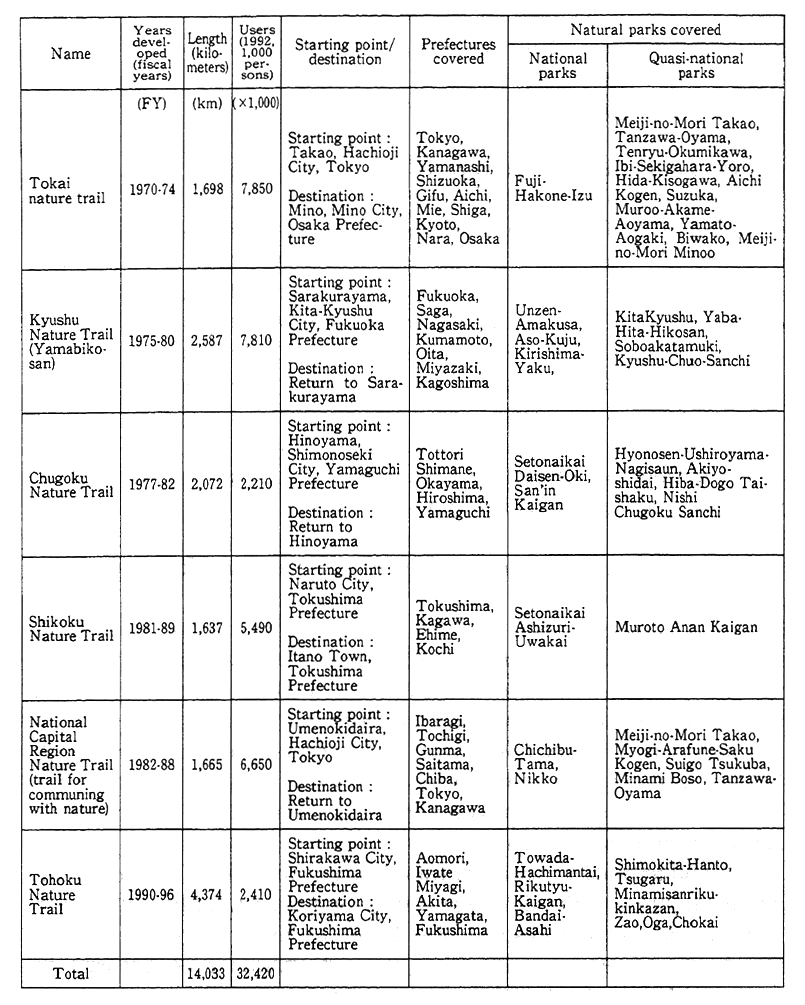
Remarks : Only part of the Tohoku Nature Trail is open.
(6) Family Camping Villages.
The Environment Agency has established family camping villages in 10 regions blessed with large areas of forests to provide people living in metropolitan areas with places where they can stay for extended holidays.
(7) Measures to Promote Mountain Village Vacations
Family Camping Villages provide basic outdoor camping facilities where people can enjoy low-priced holidays in a natural environment. These villages are provided in response to an increasing desire among people living in metropolitan areas to go on recreation and sightseeing trips. The facilities are designed giving due consideration to the unspoiled environment in which they are located and are intended to enhance people's interaction with the natural environment as well as promote tourism in the local areas.
In fiscal 1993, construction of Family Camping Villages commenced in the following locations: the Rikuzen Takata district in Iwate Prefecture ; the Asahi district in Yamagata Prefecture; and the Ume district in Oita Prefecture.
(8) Family Travel Villages
Family Travel Villages are facilities located where families can go on short nature sightseeing trips. At the same time, these villages contribute to promoting tourism in the local areas. In fiscal 1993, the Environment Agency carried out projects to develop or upgrade such facilities in 9 different areas.
(9) Nature Houses for Young People
These are group lodgings that are used for the purpose of allowing children to gain a closer experience with nature, as well as providing the opportunity for a well-rounded mental and physical educational experience in a healthy social setting. In fiscal 1991, the construction of government children homes had been completed in 14 locations throughout Japan In fiscal 1993, the Environment Agency provided assistance for a project to construct a public nature house for young people in one location.
11-5-3 Protection and Proper Use of Hot Springs
(1) Protection and Proper Use of Hot Springs
Japan has one of the largest numbers of hot springs of any country. They are particularly important to the public because of their health and recreational qualities. At fiscal 1992 year-end, there were 23, 568 hot springs throughout Japan. Of this number, 5,134 were naturalflowing hot springs and 10,931 were pump-operated, and there were 7, 502 hot springs which were not yet used by the public. The total volume of water that flows from hot springs throughout Japan every day is approximately 3,330,000 tons.
The Hot Spring Law was enacted to facilitate the conservation of hot springs and ensure their proper use. In accordance with the provisions of this law, permission must be obtained from the relevant prefectural governor to excavate at the site of hot springs, expand an already excavated site, or install pumping equipment to pump hot spring water. In the case of using hot springs for public baths, or the use or sale of water from hot springs as bathing or drinking water, permission can also be obtained from prefectural governors or mayors of specified cities.
The types of permits granted for the above types of projects were as follows : excavation, 815 permits; additional excavation 71 pernuts installation of pumping equipment, 613 permits; the use of hot springs as public baths, or the use of water from hot springs as bathing or drinking water, 2,213 permits.
(2) Hot Spring Health Resorts
In accordance with the provisions of the Hot Springs Law, areas having hot springs that are expected to be frequently used in the future by the public and existing popular hot spring health resort areas are designated by the Director General of the Environment Agency as "Hot Spring Health Resorts." As of the end of January 1994, 80 locations covering a total area of 12,042.06 hectares had been designated as "Hot Spring Health Resorts."
From fiscal 1993, the Environment Agency began designating hot springs set in natural surroundings as "People's Recuperation Spa Areas" (that promote health) and assisted with such facilities as nature trails and camping sites, etc.
From fiscal 1993, the Environment Agency began selecting certain sites as "Nature-Friendly, Relaxing Spa Areas" that, thanks to their natural resources, are suitable for nature education and mental refreshment. In 1993, five sites were designated as such areas and the Environment Agency assisted with such facilities as camping sites and so on.
11-6 Conservation and Development of the Natural Environment in Urban Areas
11-6-1 Conservation and Development of the Natural Environment in Urban Areas
The natural environment in urban areas plays a significant role, such as in air purification and the easing of climate conditions, and is indispensable for the creation of a comfortable urban environment, including providing space for recreation. The following measures were taken for conservation of the natural environment in such urban areas.
(1) Development of National Gardens and National Cemeteries for the War Dead
The Outer Garden of the Imperial Palace, the Shinjuku Imperial Garden, and the Kyoto Imperial Garden have been under the custody/ managed by the Environment Agency since 1971. These are very popular places for the public to visit.
The Outer Garden of the Imperial Palace, including the Kita-noMaru section of the garden, covers an area of 114.9 hectares. The Kita-no-Maru section is developed as a forest park primarily with Japanese black pine trees and lawns.
The Shinjuku Imperial Garden blends Japanese and Western styles typical of the Meiji era and covers an area of 58.3 hectares. Within the garden confines there are approximately 1,900 cherry blossom trees, which include among their number 50 different species. There are flowers blooming all year round to increase the attractiveness of the park to visitors, who number about 900,000 through the course of the year.
The Kyoto Imperial Garden surrounds the Kyoto Imperial Palace and has a rectangular shape, stretching for 1,300 meters north and south, and 700 meters east and west of the Palace walls. The total area of the garden is 65.3 hectares, and it plays the role of a central park for the city of Kyoto.
There are "mother and child forests" found in both the Kyoto Imperial Garden and the Shinjuku Imperial Garden, with the aim of promoting interaction between children and nature. These areas are used for observing nature and other related activities.
The gardens at the Chidorigafuchi National Cemetery for the War Dead cover an area of about 1.6 hectares. As of March 1994, the ashes of 334,496 servicemen who have no surviving family or whose surviving family could not be located were enshrined at the cemetery.
In fiscal 1993, various projects were undertaken to contribute to the pleasant use of the gardens by the public, including the repair of garden paths, the cleaning of ponds, and general gardening activities such as planting trees and tending lawns. In addition, measures were taken to improve the quality of water in the moats surrounding the gardens, and to this end, steps were taken to develop water quality management programs.
The Wadakura Fountain Park and surrounding area were renovated in preparation for the marriage of the Royal Crown Prince and Princess, and the fountain in the park was constructed in 1961 to commemorate the wedding of the Emperor and Empress.
(2) Development of City Parks
Parks are one of the most important public facilities in urban areas, serving numerous environmental and social purposes. For example, the vegetation in parks helps reduce urban pollution, and they act as places of shelter in times of natural disasters. In addition parks provide the wide open spaces that are indispensable for many sports and other recreational and cultural activities.
The development of parks and park facilities is progressing under five year plans in accordance with the provisions of the Law Relating to Urgent Measures for the Improvement of City Parks. At the end of fiscal 1991, there was approximately 6.1 m park land for every person who lived in areas covered by park development plans. Further planned development of parks is required to meet the request of people living in urban areas for more recreational facilities and space.
Fiscal 1993 was the third fiscal year of the fifth Five Year Plan for the Development of City Parks. The aim of the plan is to increase the area of park space per person in areas covered by the plan to 7.0 m2 by the end of fiscal 1995 The plan has a budget of ¥5,000 billion, including ¥2,230 billion for general public works projects. In fiscal 1993, ¥334.8 billion was spent on projects to develop parks and improve park facilities in urban areas (Table 11-6-1).
Table 11-6-1 Progress toward Completion of Projects under the Fifth Five-Year Plan for the Development of City Parks and Park Facilities
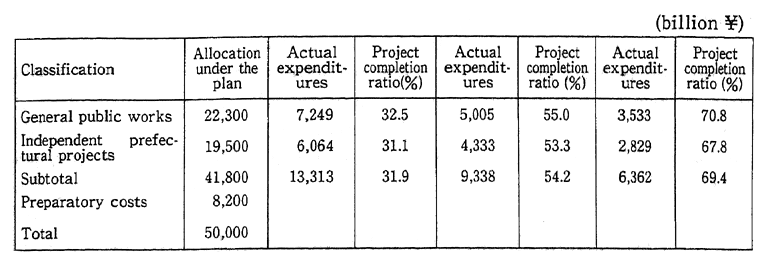
Remarks; 1. Actual expenditures through fiscal 1993 include Funds for Public Projects to Promote the Development of Land for Residential Use.
2. Figures for independent prefectural projects for fiscal 1993 and 1994 include Funds for Creating and Improving Land Tracts in and around Large-Scale Parks.
(3) Conservation of Urban Green Space
The City Green Zone Conservation Law was introduced to conserve those urban areas with a healthy growth of trees and other vegetation. At the end of fiscal 1994, approximately 3,449 hectares of land, including Suburban Green Space, had been designated as Green Space in accordance with the provisions of the law. Development activities are strictly limited in these areas. Additional activities to conserve urban green space include the purchase of land which can be described as urban green space. About 85 hectares of land had been purchased by fiscal 1992 and another 2 hectares were purchased in fiscal 1993.
At the end of fiscal 1991, greening agreements had been concluded in 865 districts in 107 cities to promote the planting of trees and other greening activities.
(4) Designation of Suburban Green Space
Under the Law for the Conservation of Green Belts around the National Capital Region and the Law for the Development of Conservation Areas in the Kinki Region, 24 districts with a total area of 97,000 hectares have been designated as Suburban Green Space. Under the provisions of these laws, notification must be given of an intention to do anything that might have an impact on the natural environment of areas designated as Suburban Green Space. Of this number, 18 districts covering an area of approximately 2,639 hectares that require urgent conservation measures are designated as Special Areas for the Conservation of Suburban Green Space, and a licensing system has been introduced to regulate certain types of development. Additional activities to preserve suburban green space include the purchase of land which can be described as suburban green space. Approximately 166 hectares of land were purchased by fiscal 1992, and approximately 0.6 hectares in fiscal 1993.
(5) Designation of Agricultural Zones in Urban Areas
In areas for urbanization, "agricultural zones" are specified in city planning in accordance with the Productive Green Land Law which was amended to systematically conserve farmland and form a favorable urban environment. As regards land in the zones, landowners are obligated to manage farmland, and for the development of housing sites, permission of competent municipal mayors is required for the construction of new buildings. As of the end of 1992, agricultural zones were designated with a total area of about 15,000 hectares under the amended Agricultural Land Law.
11-6-2 Protection of Cultural Properties and the Conservation of Historical Environments
(1) Protection of Historic Sites, Beauty Spots, and Natural Monuments
Any interference with or alteration of the following sites or objects is restricted under law: ancient tombs, burial mounds, castle ruins, and other places of historic and scientific value designated as historic sites; gardens and other scenic spots valued for their artistic and aesthetic qualities, which are designated as beauty spots ; flora, fauna, geological resources, and other records of nature of scientific value, which are designated as "natural monuments."
At the end of fiscal 1992, 1,309 places had been designated as historic sites, including 57 special historic sites; 257 places had been designated as beauty spots, including 28 special scenic spots ; and 913 places had been designated as natural monuments, including 721 special natural monuments.
Important historical sites were also transferred to public ownership, and various projects to provide facilities to enhance the public's enjoyment of these sites were undertaken.
In addition to these conservation efforts, the Nara National Cultural Institute carried out further excavation and maintenance work at Heijokyo and Asuka-Fujiwarakyo historical sites.
Measures are being implemented to halt the decline in species of flora and fauna designated as national monuments that has accompanied the development of national land in recent years. These include projects to protect these species and their natural habitats and propagation programs to increase their numbers.
(2) Protection of Traditional Architecture Preservation Districts
Much traditional architecture is concentrated in old post and castle towns. Those which are of particular national historical importance are designated as traditional architecture preservation districts, and measures are implemented to preserve historic buildings in these areas as well as the surrounding environment, which forms an integral part of the overall history of these places. These include structural repair projects, the installation of disaster prevention facilities, and the subsidizing of projects to transfer land and buildings to public ownership. At the end of fiscal 1993, 37 districts in 32 municipalities had been selected for assistance.
(3) Preservation of the Historical Features of Ancient Cities
Approximately 13,000 hectares of land has been designated as areas for the preservation of historical features in accordance with the provisions of the Law Concerning Special Measures for the Preservation of Historic Features of Ancient Cities. These areas include land in Kyoto and five other cities, one town, and one village, which have been designated as Ancient Cities. Within this area, 4,532 hectares of land in 39 districts has been designated as "special areas for the preservation of historical features," because of the particular historical significance of the features in these areas.
Under the Law for Special Measures Concerning the Preservation of Historical Features and the Development of the Living Environment in Asuka Village, 125.6 hectares of land in Asuka, in Takaichi County of Nara Prefecture, has been designated as a Class 1 area, and 2,278.4 hectares has been designated as a Class 2 area, for the preservation of historical features.
Also under the Program for the Development of the Living Environment and Industrial Infrastructure in Asuka Village, a wide variety of projects in tune with the preservation of its historical features is promoted.
In special areas for the development of historical features, permission must be obtained from the local governor to commence construction of office buildings or industrial structures which will have an impact on any historical feature. Other preservation measures include land purchases. By fiscal 1992, about 322 hectares of land, and in fiscal 1993, another 11 hectares of land was purchased.
In these areas, assistance to projects for the development of facilities, which are being executed under historical feature preservation programs, is subsidized. In fiscal 1993, ¥9.2 million was spent on projects to promote planting to preserve historical landscapes.
To preserve historical features in areas outside those designated as special areas for the preservation of historical features, notification must be given to the prefectural governor for any new construction activities.